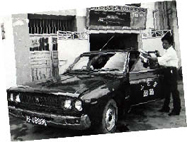|
Pierre Cardin Fashion Show
Pierre Cardin is known as a "Fashion Missionary" to the Chinese, since he was the first person to introduce Western fashion to China. In 1979, he led his team of French models to Beijing and staged a fashion show at the Cultural Palace of Nationalities. The tall and sensuous foreign beauties parading on the catwalk astounded the Beijing audience, which was clad in the typical blue or gray of the day, and the show was the talk of the town. At the time, China knew nothing of fashion and fashion designing.
1980
Special Economic Zones
Following the introduction of reforms in 1978, Deng Xiaoping, who is generally credited with the innovation, continued sending a clear message to the Chinese people. "We should acknowledge imbalance," he said. "The practice of equilibrium brings no hope. Our economic policy should allow a few areas, a few enterprises and a few workers and farmers who work diligently and effectively to obtain more income and live a better life than others. Only when some areas have prospered first can the state have the ability to help backward areas."
After careful discussion in 1980, the central government accepted the request of Guangdong and Fujian provinces to "take a move ahead of others" and approved the establishment of special economic zones (SEZ) in Guangdong's Shenzhen, Zhuhai and Shantou, and Fujian's Xiamen.
SEZs welcome foreign capital, practice a market economy and offer preferential terms to foreign investors with regard to land use, taxes and foreign exchange management in order to encourage exports and raise revenues. This was the first time that China opened special zones to foreigners since 1949.
The four experimental zones brought two decades of high-speed economic growth for Guangdong and Fujian, propelling China's economic takeoff. In 1984, the central government opened up 14 coastal cities and established three economic open zones along its coast, including the Yangtze River Delta and the Pearl River Delta. In 1988, Hainan Island was made an SEZ. The result has been an economic miracle.
The Self-Employed
 |
|
A self-employed cab driver in Guangxi. |
Initially, the self-employed were composed of two types of people, unemployed young urbanites (mostly middle school graduates who waited for the government to assign them a job), and business-savvy farmers. They saw opportunities that arose from the disparity between the increasing consumption needs of the public and the shortage of supply under the planned economy.
They earned handsome profits either through trading between different areas or through deep processing of agricultural products. Many nouveau riche with an annual income of RMB 10,000 or more appeared among them, when the average annual salary of government employees was just a few hundred RMB.
However, their social status remained low, and they had to face constant social biases. A few law violators among them smeared their reputation even further, and people often considered them immoral opportunists and tax evaders. The social environment began to improve in the mid-1980s, and for a time the "self-employed" as an occupation ranked highest on the rating of occupation preferences. The "self-employed" sector and the private corporate economy that was born later have remained the most dynamic elements in the 30 years of China's rapid economic growth.
| 